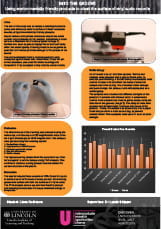by Liam Robinson //
 The aim of this study was to identify a safe and effective cleaning method to remove surface dirt from vinyl audio records using environmentally friendly products.
The aim of this study was to identify a safe and effective cleaning method to remove surface dirt from vinyl audio records using environmentally friendly products.
Sound archives and private collections around the world contain large numbers of vinyl records. Maintaining a clean surface is important for effective playback and reduces the risk of damage to the records and playback equipment.
Surface dirt such as greasy fingerprints or dust from improper storage and handling can seriously affect the sound quality. Any cleaning should be as gentle as possible to minimise potential permanent damage. There is currently limited research on safe plastic cleaning methods and none on LP records.
This study compared two environmentally friendly products against water alone. These were; Orvus WA (an animal shampoo also used for textile cleaning) and Synperonic A7 (a detergent widely used by conservators). Many detergents can cause environmental damage when discharged into the water system, so it is vital for conservators to find environmentally friendly alternatives.
In order to evaluate the suitability and effectiveness of these products, an LP record was cut into three-centimetre squares. Twenty-four samples were prepared with a greasy thumb print to simulate poor handling. Another twenty-four samples were soaked in water with card from the record sleeve and compressed while drying. This simulated water damage and poor storage. Six samples were left unprepared, as a control group for comparison.
The samples were cleaned with different strengths of the products in solution with distilled water. A cotton swab was used to apply the solution to the surface. This was gently swept along the surface in the direction of grooves. The samples were then swabbed using distilled water to remove any traces of the product. Finally, the sample was dabbed dry with a paper towel and placed in a clean sealed bag to prevent any contamination.
The effectiveness of the cleaning was evaluated using the naked eye, a microscope at x20 magnification and a Dino-lite digital microscope at x240 magnification. The grading system for each of these was:
1. No significant change
2. Large quantity of dirt still present
3. Obvious traces of dirt remain
4. Very little dirt remains
5. No dirt remains
The highest scoring sample from this evaluation was then tested against a control sample, using FTIR (Fourier Transform Infrared Spectroscopy) analysis to check that the cleaning product had not altered the carbon structure of the plastic.
The results showed that a solution of 10% Orvus WA paste in distilled water was the most effective product for removing grease and surface dirt from the surfaces of vinyl records. The FTIR analysis carried out confirmed that this product and cleaning method does not damage or change the carbon structure of the plastic.
The findings of this study have helped to identify an environmentally friendly and effective cleaning product for use on vinyl records. This could be further developed by examining cleaning techniques, testing on a larger sample group and assessing the effect on playback sound quality.
Liam Robinson is studying a BA (Hons) degree in Conservation of Cultural Heritage at the University of Lincoln.
*To view Laurence’s project poster, please click on the thumbnail below:

